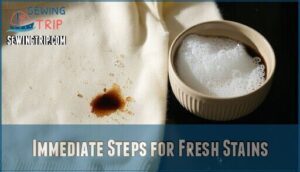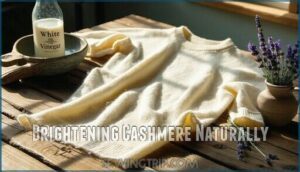This site is supported by our readers. We may earn a commission, at no cost to you, if you purchase through links.
 Bleaching cashmere is a terrible idea—you might as well take a torch to your wallet. The harsh chemicals eat away at those delicate protein fibers, stripping color permanently and making the fabric 3.3% weaker.
Bleaching cashmere is a terrible idea—you might as well take a torch to your wallet. The harsh chemicals eat away at those delicate protein fibers, stripping color permanently and making the fabric 3.3% weaker.
What you’re left with is an expensive disaster: faded, fragile, and frankly unwearable.
Cashmere’s protein structure can’t handle harsh chemicals, especially alkaline solutions. Instead, you’ll want to stick with gentle alternatives like oxygen bleach, baking soda, or white vinegar for brightening. These safer methods can actually restore your cashmere’s natural beauty without the chemical warfare.
Table Of Contents
Key Takeaways
- You can’t bleach cashmere—it permanently damages the delicate protein fibers, causing up to 3.3% strength loss and irreversible color changes that’ll ruin your expensive sweater.
- You’ll need gentle alternatives like oxygen bleach, white vinegar, or specialized wool detergents to safely remove stains and brighten your cashmere without destroying the fibers.
- When stains happen, you should act fast by blotting (never rubbing) with cool water and cashmere-safe cleaners, then hand wash in lukewarm water and lay flat to dry.
- You can extend your cashmere’s life by storing it properly with cedar blocks or lavender sachets, using cashmere combs for pilling, and getting professional cleaning once or twice yearly.
Can You Bleach Cashmere?
You shouldn’t bleach cashmere because it damages the delicate fibers and causes permanent color loss.
Standard household bleach containing sodium hypochlorite breaks down cashmere’s natural keratin structure, making your favorite sweater weak and discolored.
Effects of Bleach on Cashmere Fibers
When bleach hits cashmere fibers, it’s like taking a sledgehammer to fine lace. Regular household bleach destroys the fiber structure instantly, and the damage can’t be reversed.
Household bleach destroys cashmere’s delicate protein fibers instantly, causing irreversible damage that turns luxury fabric into expensive rags
What actually happens to your cashmere:
- Tensile strength loss up to 3.3% from chemical exposure
- Color alteration and permanent fading that can’t be undone
- Fiber degradation that weakens the entire garment structure
Skip bleach entirely—safer stain removers and bleach alternatives exist for effective stain removal.
Chemical Sensitivity of Cashmere
Understanding cashmere’s chemical sensitivity helps explain why harsh cleaners cause permanent damage. The protein fibers contain keratin structures that break down when exposed to alkaline solutions.
Oxidation effects from bleach and strong stain removers create fiber degradation, leading to weight loss and reduced tensile strength. Even mild chemical exposure damages these delicate fibers permanently.
Maintaining the quality of cashmere requires careful handling during cashmere fiber preparation.
Why Bleach is Not Recommended
Never use bleach on your treasured cashmere pieces. Chemical bleaches cause irreversible damage and fiber degradation, weakening tensile strength by up to 3.3%. You’ll face permanent color alteration and structural breakdown that destroys delicate fabrics.
Instead, choose gentle bleach alternatives for effective stain removal while preserving your delicates through proper fabric care.
What Happens When You Bleach Cashmere?
When you bleach cashmere, you’re basically attacking the protein fibers that make your sweater soft and strong.
Studies show bleach causes up to 3.3% tensile strength loss and irreversible color damage, turning your luxury garment into a weakened, faded mess.
Fiber Damage and Strength Loss
Bleach attacks cashmere’s protein structure like acid on metal. When you expose cashmere to bleaching agents, you’re looking at serious damage:
- Tensile strength drops up to 3.3% after bleach exposure
- Keratin disruption breaks down the fiber’s natural structure
- Fiber elasticity decreases permanently from alkaline damage
- Weight loss ranges from 0.65% to 2.45% depending on bleach concentration
Oxidation bleaching literally eats away at your cashmere, making stain removal pointless if there’s no sweater left.
Color Fading and Irreversible Changes
Most bleach creates permanent color changes that you can’t undo. The chemicals strip away your cashmere’s natural dyes, leaving behind faded patches or yellow stains.
Unlike sunlight effects that happen gradually, bleach alteration occurs instantly. Professional color restoration rarely works on damaged cashmere fabric, making proper garment care with gentle detergent your best defense against irreversible damage.
Scientific Studies on Bleaching Cashmere
You’ve probably noticed bleach ruins cashmere—and research confirms why.
Cashmere loses up to 3.3% of its fiber strength when it meets bleaching solutions. The damage happens quickly too. Household bleach breaks down those delicate fibers in less than a day by disrupting the keratin structure.
As the yarn type matters, animal-based yarns like wool are particularly vulnerable to damage from bleach. Oxidation fiber loss ranges from 0.65% to 2.45%, depending on reagent concentration impact, causing irreversible fiber damage that ruins your sweater permanently.
How to Safely Remove Stains From Cashmere
When you spot a stain on your cashmere, don’t panic—quick action saves your favorite sweater from permanent damage.
You’ll need the right techniques and gentle products to treat stains without harming those delicate fibers.
Immediate Steps for Fresh Stains
When you spot a stain on cashmere, speed matters more than anything. Blot the area with a clean cloth—don’t rub, which pushes stains deeper into delicate fibers. Cool water works best for immediate treatment while you identify what caused the mess.
- Blot, don’t rub – Press gently with a clean white cloth to absorb liquid
- Use cool water only – Hot water sets protein-based stains permanently
- Act within minutes – Fresh stains lift easier than set-in ones
Suitable Detergents and Stain Removers
You’ll want gentle detergents specifically designed for delicate fabrics when tackling cashmere stains. Wool wash or baby shampoo work perfectly for most spots.
The Laundress Stain Solution effectively addresses common stains without harsh chemicals. Never use OxiClean or regular detergent—they’re too aggressive.
Natural solutions like diluted white vinegar can brighten yellowed areas safely.
Spot Cleaning Techniques
When tackling fresh stains on cashmere, quick action prevents permanent damage. Start with stain assessment to determine the best approach for each type.
- Blot stains gently with a clean cloth—never rub or scrub the delicate fibers
- Use cool water and gentle agitation with fingertips around the stained area
- Apply The Laundress Stain Solution or baby shampoo directly to stubborn spots
- Focus on thorough residue removal by rinsing multiple times with cool water
- Choose proper drying methods by laying flat and reshaping while damp
Professional cleaning remains your safest bet for valuable pieces.
Removing Set-in Stains
Set-in stains require more persistence than fresh ones. Create a paste using gentle detergent and cool water, then apply it directly to the stain. Let it sit for thirty minutes before rinsing.
For stubborn old stain removal, enzyme stain treatment works well on protein-based marks.
If DIY stain solutions fail, professional cashmere cleaning or cashmere restoration services can save your garment from permanent damage.
How to Whiten Cashmere Without Bleach
You can brighten yellowed or dingy cashmere using gentle alternatives that won’t damage the delicate fibers like harsh bleach would.
White vinegar, oxygen-based cleaners, and specialized wool brighteners work effectively to restore your cashmere’s original color without the fiber damage that comes with traditional bleaching agents.
Gentle Whitening Alternatives
Sometimes you can’t rescue severely dingy cashmere with standard detergent alone. These Natural Brighteners offer safer paths than harsh chemicals during handwashing:
- Oxygen Bleach – Mix with gentle detergent for stains without fiber damage
- Baking Soda – Add to lukewarm water for gentle cleaning power
- Vinegar Rinse – Use white vinegar to dissolve mineral buildup naturally
Brightening Cashmere Naturally
Natural brighteners like white vinegar work wonders for color restoration without harsh chemicals. Mix one part white vinegar with three parts cool water for gentle cleaning that lifts stains from cashmere naturally.
Sunlight exposure also helps brighten fibers—just limit it to prevent fading. These oxygen boosters refresh your garment through careful handwashing techniques.
Recommended Products for Whitening
You need specific products that won’t damage delicate fabrics. Skip enzyme detergents and optical brighteners—they’re too harsh for cashmere. Instead, choose pH-neutral formulas designed for whitening without UV light or oxygen bleach exposure.
- The Laundress Wool & Cashmere Shampoo protects your investment
- Eucalan No Rinse detergent saves your precious sweater from color restorers
- Pure Collection Cashmere Wash prevents hydrogen peroxide damage to stains
Best Washing and Drying Practices
You’ll want to master the right washing and drying techniques to keep your cashmere looking its best for years.
Think of it like caring for a delicate houseplant—the wrong approach can quickly turn your prized sweater into an expensive cleaning cloth.
Hand Washing Instructions
Before handwashing cashmere, fill a clean sink with lukewarm water and add wool wash detergent. Submerge your sweater completely, then use gentle swirling motions—never aggressive agitation.
Let it soak for fifteen minutes, occasionally swirling softly. After soaking, squeeze out excess water carefully without wringing, then lay flat on a white towel for drying.
Recommended Water Temperature
Water temperature can make or break your cashmere washing routine. Get it too hot and you’ll end up with a sweater that fits your toddler instead of you.
The sweet spot? Aim for lukewarm water around 85°F when washing, then switch to cold for the rinse.
- Lukewarm vs. Cold: Use lukewarm water (around 85°F) for washing, cold for rinsing
- Temperature Consistency: Keep water temp steady throughout the process to prevent fiber shock
- Water Softness: Soft water works better than hard water for gentle cleansing
Hot water causes fiber swelling and threatens dye stability in colored cashmere pieces.
Drying and Reshaping Techniques
After washing with cool water, squeeze out excess moisture gently—never wring your cashmere.
Lay it flat on a white bath towel or drying rack for proper flat drying. Shape the sweater back to its original dimensions while damp for better shape retention.
This blocking cashmere technique prevents stretching and maintains the garment’s silhouette during the drying process.
Lint and Fuzz Removal Tips
Once your cashmere’s properly dried, you’ll need to tackle those pesky pills and fuzz. A cashmere comb works wonders for pilling prevention—gently brush in one direction to maintain fibre length.
Lint roller types vary, but fabric rollers beat sticky ones for delicate fibres. For stubborn pills, use a fabric shaver guide: work slowly with light pressure.
Static cling reduction comes from proper humidity levels during storage.
Long-Term Care for Cashmere Garments
You’ll want to treat your cashmere like the investment it is, since proper long-term care can extend its life to over 200 wears across ten years.
Smart storage, regular maintenance with the right tools, and preventive measures will keep your cashmere soft, shaped, and stain-free for years to come.
Proper Storage and Humidity Control
Storing cashmere properly prevents moths and mildew from ruining your investment. Keep humidity levels between 30-50% to avoid moisture damage.
Cedar alternatives like lavender sachets work great for moth prevention without harsh chemicals.
Fold garments loosely using acid-free tissue paper, or try vacuum sealing for long-term storage. Cool, dry spaces beat humid closets every time.
Maintaining Softness and Shape
Though your cashmere deserves royal treatment, maintaining its softness and shape doesn’t require magic.
Here’s what you need to know:
- Hand wash with gentle detergent in lukewarm water
- Skip fabric softener—it coats delicate fibers
- Press water out gently, never wring or twist
- Reshape while damp for proper drying
These washing instructions preserve your investment for years.
Tools for Cashmere Maintenance (Combs, Rollers)
The right tools make all the difference for cashmere garments. A cashmere comb removes up to 90% of pills in just 2-3 uses, while lint rollers handle loose fibers but miss stubborn pilling.
Use combs on dry fabric with steady, one-direction strokes. Quality stainless steel mesh combs outlast plastic alternatives by 20%, making them worth the investment for pilling prevention.
Preventing Future Stains and Damage
Before stains strike, you’re your cashmere’s best defense. Keep drinks and messy foods away from your precious pieces.
Store garments in breathable cotton bags, not plastic. Check for moth damage monthly.
When accidents happen, blot immediately—don’t rub. Schedule professional cleaning annually for deep maintenance.
These simple habits prevent costly repairs later.
Frequently Asked Questions (FAQs)
Can I use bleach on a cashmere blend?
Like mixing oil and water, bleach and cashmere blends don’t play nice together. You’ll damage the delicate cashmere fibers permanently, causing weakness, discoloration, and potential holes.
Skip bleach entirely—use gentle, cashmere-safe detergents instead.
What are the best ways to remove stains from cashmere?
Treat fresh stains immediately with cool water and gentle cashmere wash or baby shampoo.
Avoid bleach completely—it damages cashmere fibers permanently.
Use specialized stain solutions designed for delicate fabrics instead.
How do I wash cashmere after stain removal?
Once you’ve tackled the stain, fill your sink with lukewarm water and add gentle wool wash or baby shampoo.
Submerge your cashmere, swirl gently, then soak for fifteen minutes. Squeeze out excess water carefully and lay flat to dry.
What are the best soaps for cashmere clothing?
You’ll want wool wash or gentle baby shampoo for your cashmere pieces. These specialized detergents won’t strip the delicate fibers like harsh soaps do. Avoid regular laundry detergent completely.
How do I dry cashmere after washing?
Lay your cashmere flat on a clean towel or drying rack after washing. Never hang it—that’ll stretch the fibers. Gently reshape while damp to maintain its original form.
Can cashmere shrink from other washing mistakes?
Studies show cashmere loses up to 45% fiber mass from washing mistakes.
You’ll definitely shrink your sweater using hot water, aggressive agitation, or wringing it out. These errors damage the delicate fibers permanently.
What temperature ruins cashmere permanently?
Hot water above 85°F (29°C) permanently damages cashmere fibers, causing shrinkage and felting. You’ll lose that luxurious softness forever if you exceed lukewarm temperatures during washing.
How often should cashmere be professionally cleaned?
You’ll need professional cleaning once or twice yearly for cashmere pieces. Frequent dry cleaning damages delicate fibers, so stick to gentle home washing between professional treatments.
Can moths damage cashmere during storage?
Moths absolutely love cashmere’s protein fibers—they’re like an all-you-can-eat buffet. Store your pieces in sealed containers with cedar blocks or lavender sachets to keep these fabric-munching pests away.
Which fabric softeners are safe for cashmere?
Skip commercial fabric softeners entirely for cashmere. They coat fibers and reduce breathability. Instead, use white vinegar in your rinse water or specialized cashmere conditioners to maintain softness naturally.
Conclusion
Your bathroom bleach will wreck cashmere in seconds. The protein fibers that make cashmere so soft break down completely when hit with chlorine bleach.
Instead, stick with gentle alternatives like oxygen bleach, white vinegar, or specialized wool detergents. These methods preserve your garment’s softness and strength while effectively removing stains.
With proper care techniques, your cashmere will stay beautiful for years without needing aggressive treatments.
- https://yadda.icm.edu.pl/baztech/element/bwmeta1.element.baztech-ba954665-e7c0-47af-90c7-63e0a118b18a/c/4_comparison_of_the_structure_and_properties_fibres_2018_4.pdf
- https://plushmina.com/en-us/blogs/luxury-looms/how-to-get-stains-out-of-cashmere
- https://www.sciencedirect.com/science/article/pii/S1878535224003551
- https://patents.google.com/patent/CN103243542A/en
- https://www.frontiersin.org/journals/materials/articles/10.3389/fmats.2022.987608/full
















